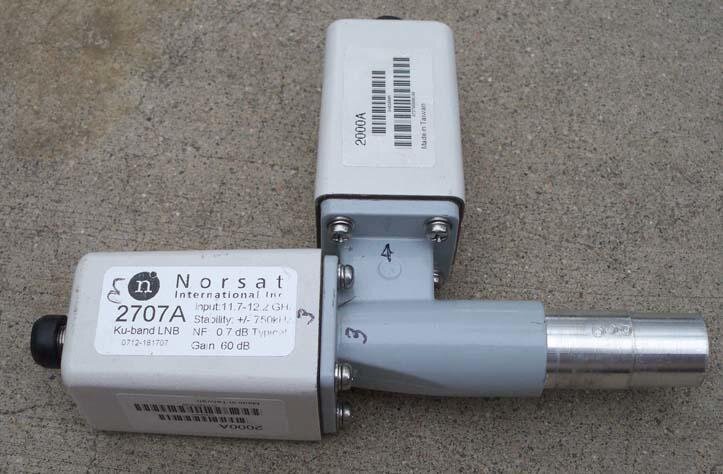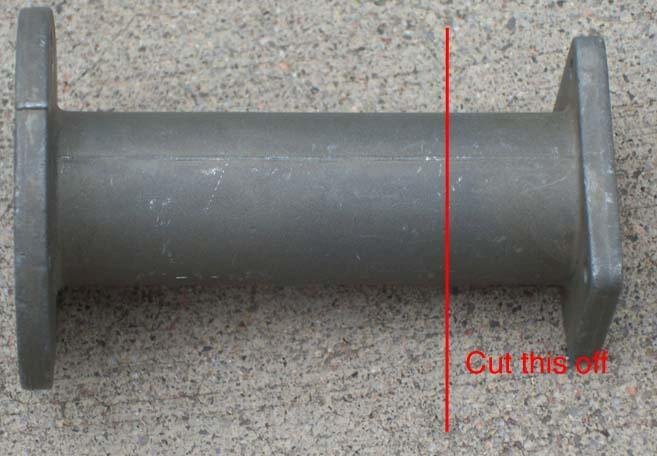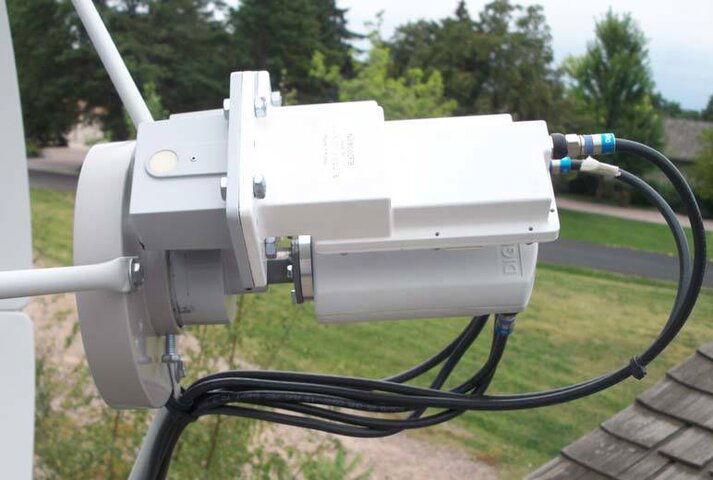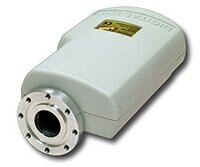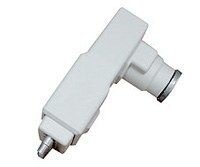This thread has been a long time in in the making, but thanks to a kick from zamar23 and today being completely unproductive with school starting for all the kids, I threw in the towel and took some pictures on the roof.
Long ago I started with a 3m Winegard perf and decided to put on a dual orthomode feed with Norsat 8115s and 2707s as LNBs. As it was my only FTA dish everything worked fine, or so I thought. I could lock just about everything on C and Ku with good SQ. But the family traffic got a little heavy on the 3m, so I started adding more dishes. I wasn't very happy, at least initially, to find that a Geosatpro 1.2m with an Invacom QPH-031 LNBF (quad Ku with linear and circular polarizations) pretty well equaled or bettered Ku on the 3m. Then I put up a 1.8m solid for C-band only, and while the 3m stomped it, the difference wasn't as much as I calculated that it should be.
This started me down the road of feed modifications. I wrote a thread some time ago about hacking up the scalar rings on a dual ortho to better match a deep dish like the Winegard. That got my C-band performance up on the 3m to where it made sense given the 1.8m performance. This demonstrated the dual ortho was initially under-illuminating the Winegard's f/D of 0.278. While I could fix C-band, there was not much I could do to get the Ku part of the feed to see more of the 3m.
A 2.3m mesh arrived next with a f/D of 0.35. I figured maybe this would be a better match for the dual ortho because of the higher f/D. But Ku performance was horrible. My conclusion was the surface was simply too inaccurate for Ku, although worked fine for C.
The final stop for the dual ortho was my homely 1.8m. I had since put single ortho (C-band only) feeds on the larger dishes and measured a slight improvement in performance. I was nearly ready to dump the dual ortho, but I had picked up an Invacom QTF-031 quatro universal Ku LNB with a prime focus ADF-120 feed and was trying to decide between matching the ADF-120 to an extra Geosatpro 1.2m that was collecting dust or a second 1.8m prime focus that would have to be acquired. The Geosatpro would have been an interesting experiment, as it has a fairly low f/D of 0.5. I wondered whether a carefully modified ADF-120 would be a better match than an offset feed designed for say f/Ds of 0.6 and above. Under-illumination again.
I modified the ADF-120 but never tried it on the 1.2m because the first test was the ADF-120 + QTF-031 combo on the 1.8m. I had a Ku clamp for this dish, but it was lousy and I wasted far too much time trying to get the assembly mounted and centered. Performance was good but mechanically awful.
Then the light clicked while looking at the soon-to-be-sledge-hammered dual ortho feed sitting next to the 1.8m. That was mechanically rock solid on the 1.8m, and perhaps I could pull off the Norsat Ku LNBs and substitute the Invacom QTF-031. This would save buying another 1.8m and I had a friend who was interested in my extra 1.2m. Because there isn't a lot of low band Ku universal available in Colorado, the Invacom would be a good operational match to the primarily C-band only use of the 1.8m.
So off with the Ku waveguide and Ku LNB mounts (see first picture). Note on the right side the tubing has three successive diameters; this slides into the back of my ADL RP3-2-2B feed and is held with set screws. The Chaparral Bullseye looks very similar and can likely be similarly modified.
Next came an otherwise useless flange leftover from a Superdish 121 feed assembly (next picture). I had liberated many 119 and 121 feeds from each other with a hacksaw to use the 121 LNBs and feeds on my toroid. That left me with a box of 119 feeds, flanges and LNBs to stare at. The flange is a C120, which is the same used by the Invacom, and the waveguide diameter was only a bit larger than the dual ortho port in the back. Off with its head! (see next picture).
The rest was easy. One can either mill or file the Superdish tube to fit the dual ortho feed. It works best with two steps as in the original Ku waveguide. I was on the roof so a file seemed the more appropriate weapon, and in a couple of minutes everything fit perfectly. Down came the lousy Ku feed holder on the 1.8m (and straight to the sledge-hammer) and up went the Frankenstein dual ortho C/Ku-universal assembly. It performed so well that I pardoned the dual ortho and it became my permanent choice for the 1.8m. The only headache was dragging a total of six coax lines back to the switch matrix from my farthest dish.
Another alternative would be to mount an Invacom QPF-031 LNB (not the far more common QPH-031) in a similar manner. Then you would have a triple ortho with linear C, linear Ku and circular Ku. I have resisted the urge to build a quad ortho so far, but am working on options for linear and circular C on the same dish.
Long ago I started with a 3m Winegard perf and decided to put on a dual orthomode feed with Norsat 8115s and 2707s as LNBs. As it was my only FTA dish everything worked fine, or so I thought. I could lock just about everything on C and Ku with good SQ. But the family traffic got a little heavy on the 3m, so I started adding more dishes. I wasn't very happy, at least initially, to find that a Geosatpro 1.2m with an Invacom QPH-031 LNBF (quad Ku with linear and circular polarizations) pretty well equaled or bettered Ku on the 3m. Then I put up a 1.8m solid for C-band only, and while the 3m stomped it, the difference wasn't as much as I calculated that it should be.
This started me down the road of feed modifications. I wrote a thread some time ago about hacking up the scalar rings on a dual ortho to better match a deep dish like the Winegard. That got my C-band performance up on the 3m to where it made sense given the 1.8m performance. This demonstrated the dual ortho was initially under-illuminating the Winegard's f/D of 0.278. While I could fix C-band, there was not much I could do to get the Ku part of the feed to see more of the 3m.
A 2.3m mesh arrived next with a f/D of 0.35. I figured maybe this would be a better match for the dual ortho because of the higher f/D. But Ku performance was horrible. My conclusion was the surface was simply too inaccurate for Ku, although worked fine for C.
The final stop for the dual ortho was my homely 1.8m. I had since put single ortho (C-band only) feeds on the larger dishes and measured a slight improvement in performance. I was nearly ready to dump the dual ortho, but I had picked up an Invacom QTF-031 quatro universal Ku LNB with a prime focus ADF-120 feed and was trying to decide between matching the ADF-120 to an extra Geosatpro 1.2m that was collecting dust or a second 1.8m prime focus that would have to be acquired. The Geosatpro would have been an interesting experiment, as it has a fairly low f/D of 0.5. I wondered whether a carefully modified ADF-120 would be a better match than an offset feed designed for say f/Ds of 0.6 and above. Under-illumination again.
I modified the ADF-120 but never tried it on the 1.2m because the first test was the ADF-120 + QTF-031 combo on the 1.8m. I had a Ku clamp for this dish, but it was lousy and I wasted far too much time trying to get the assembly mounted and centered. Performance was good but mechanically awful.
Then the light clicked while looking at the soon-to-be-sledge-hammered dual ortho feed sitting next to the 1.8m. That was mechanically rock solid on the 1.8m, and perhaps I could pull off the Norsat Ku LNBs and substitute the Invacom QTF-031. This would save buying another 1.8m and I had a friend who was interested in my extra 1.2m. Because there isn't a lot of low band Ku universal available in Colorado, the Invacom would be a good operational match to the primarily C-band only use of the 1.8m.
So off with the Ku waveguide and Ku LNB mounts (see first picture). Note on the right side the tubing has three successive diameters; this slides into the back of my ADL RP3-2-2B feed and is held with set screws. The Chaparral Bullseye looks very similar and can likely be similarly modified.
Next came an otherwise useless flange leftover from a Superdish 121 feed assembly (next picture). I had liberated many 119 and 121 feeds from each other with a hacksaw to use the 121 LNBs and feeds on my toroid. That left me with a box of 119 feeds, flanges and LNBs to stare at. The flange is a C120, which is the same used by the Invacom, and the waveguide diameter was only a bit larger than the dual ortho port in the back. Off with its head! (see next picture).
The rest was easy. One can either mill or file the Superdish tube to fit the dual ortho feed. It works best with two steps as in the original Ku waveguide. I was on the roof so a file seemed the more appropriate weapon, and in a couple of minutes everything fit perfectly. Down came the lousy Ku feed holder on the 1.8m (and straight to the sledge-hammer) and up went the Frankenstein dual ortho C/Ku-universal assembly. It performed so well that I pardoned the dual ortho and it became my permanent choice for the 1.8m. The only headache was dragging a total of six coax lines back to the switch matrix from my farthest dish.
Another alternative would be to mount an Invacom QPF-031 LNB (not the far more common QPH-031) in a similar manner. Then you would have a triple ortho with linear C, linear Ku and circular Ku. I have resisted the urge to build a quad ortho so far, but am working on options for linear and circular C on the same dish.


